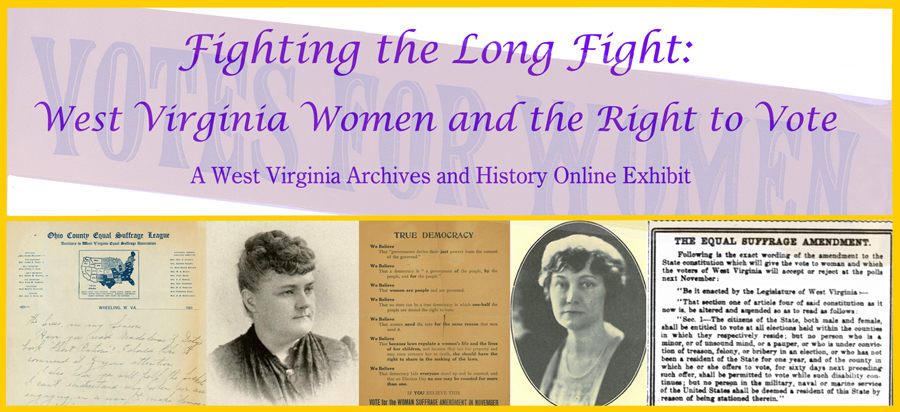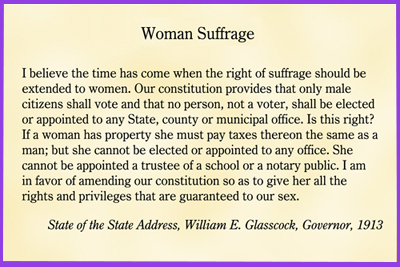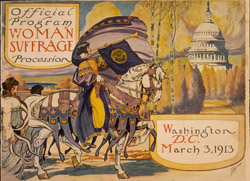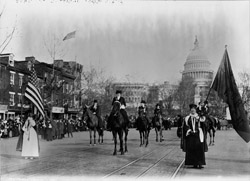
Chapter Two
"[H]ike back home and look after the children"
For the West Virginia Equal Suffrage Association (WVESA), the period from 1905 to the start of 1913 appeared to be less active. Anne Southern followed Anna Hall as president in 1905. Presidents over the next few years were Harriet Jones, May Hornbrook, Allie Haymond, and Margaret McKinney. With Wheeling and Fairmont having the strongest organizations, four of the state conventions were held in Wheeling, two in Fairmont. Describing the entire period from 1900 to 1913, Harriet Jones remarked, "During these years practically all that was done was to have speakers of note from time to time and a resolution for woman suffrage introduced in the Legislature whenever possible." (Harper, History of Woman Suffrage, 688)
In 1907 and again in 1908, Delegate A. J. Mitchell of Wirt County introduced resolutions that would have given women the right to vote in West Virginia. After the House defeated his resolution in 1907, the Clarksburg Daily Telegram declared, "Now that the constitutional amendment bill providing for the extension of suffrage to women has been killed in the house of the state legislature, the women lobbyists who were on hand to do what they could in its behalf can now hike back home and look after the children." (February 16, 1907)

Anna Howard Shaw, 1909. Library of Congress, Prints & Photographs Division, [LC-DIG-npcc-19269]
|
When a resolution was introduced a year later, supporters sent letters to members of the West Virginia Legislature. Through the efforts of Sen. Robert Hazlett, Dr. Anna Shaw and Dr. Harriet Jones were given the opportunity to address legislators on February 12. Nevertheless, the legislature failed to pass the measure. |
"The senate very graciously passed the woman's suffrage amendment on to third reading Thursday. The majority in the senate is overwhelming against suffrage, but it would not have been a very graceful thing to have killed the resolution with Rev. Anna Shaw and other prominent suffragists present." - Wheeling Daily News, February 15, 1908 |
In 1909, the legislature approved Senate Joint Resolution 1 to amend the state constitution so that women who met certain qualitifications could be appointed board members for state institutions, commissioned notaries public, and appointed to other positions. The amendment was submitted to voters in 1910 along with another amendment increasing the number of Supreme Court justices. Because of the latter, the West Virginia Bar Association printed ballots in favor of the amendments. Both amendments failed to receive the approval of voters in November 1910, although the Supreme Court amendment lost by a greater margin than the one regarding women, which received more than 40,000 votes.
On a statewide basis, the next few years appear to have been one of little activity. The West Virginia Equal Suffrage Association held annual meetings, and local organizations in Wheeling and Fairmont continued in their periodic gatherings. Those two clubs apparently did succeed in affiliating with the West Virginia Federation of Women's Clubs, which would prove beneficial later in the pursuit of woman suffrage. While not full suffrage, in November 1912 the federation did endorse school suffrage for women and the right of women to serve on boards of education.

The year 1913 brought a change in activity. Mary Johnston, a lecturer and author from Richmond, Virginia, addressed a group in the House of Delegates chamber on the afternoon of January 24, 1913, and at the Burlew Opera House that evening on the subject of woman suffrage. She also helped organized the Equal Suffrage League of Charleston. Earlier in the month, the Morgantown Political Equality Club was organized, and the women immediately planned to present a constitutional amendment to the legislature.
|
In late January, M. K. Duty, a delegate from Ritchie County, introduced House Joint Resolution No. 5, "proposing an amendment to the Constitution of this State, extending to the female citizens of this State, the right to vote at all elections held under the laws of this State." The resolution passed the House, 58-25, on February 17 but only after delegates who had opposed the measure two days earlier changed their votes after the announcement of the first vote was postponed. The Senate did not pass the resolution by the necessary two-thirds. (Journal of the House, 152, 618) In spite of its defeat in the Senate, Delegate Duty predicted the passage of women suffrage in a few years: "I remember four years ago when the question was before the house of delegates. It did not have even a majority vote at that time. This time it passed the house by the required majority . . . and it only lacked four votes in the senate. If there is the same increase in demand during the next four years the question will be submitted to a vote of the people. It is not dead by any means." (Parkersburg Dispatch-News, February 23, 1913) |
"Had it not been for Senator Kump, of Hampshire county and Senator French, of Mercer county, by whom the opposition was led on the floor of the senatte [sic] the victory would have been attained in 1913. However, both of these worthy gentlemen may have occasion to be sorry later on. . . . For the next two years the state organization will wage an aggressive and unceasing campaign to demonstrate to Senators French and Kump and the other twelve members of the upper branch who voted against the resolution that West Virginia wants suffrage and is going to have it." - Harriet Jones, Wheeling Sunday News, March 16, 1913 |

Official Program, Woman Suffrage Procession. Library of Congress, Broadsides, leaflets, and pamphlets from America and Europe Collection

Woman Suffrage Parade, Washington, DC, March 3, 1913. Library of Congress, Bain Collection, Prints & Photographs Division, [LC-USZ62-22262]
|
On March 3, twenty West Virginia suffragists, most of them from Fairmont and Wheeling but including a few women from Martinsburg, Bridgeport, Grafton, Sutton, and Weston, joined several thousand women from around the country as well as from other countries for a parade held in Washington DC on the day before Woodrow Wilson was to be inaugurated as president. The parade, intended "to give expression for the nation-wide demand for an amendment to the United States Constitution enfranchising women," was the work of Alice Paul and Lucy Burns, two American suffragists who had worked with the more radical British suffrage movement and would eventually form the National Woman's Party. The program order provided for sections of women and floats to process from the Peace Monument at the U.S. Capitol down Pennsylvania Avenue to the White House, then to Continental Hall.
Harriet Jones, who was among the marchers, commented on the parade:
The marchers were made the subject of many vulgar jests and those disgusting uniformed police officers stood idily by and permitted it. You'd have thought they were a lot of wooden men. No, it wasn't the plain clothes men who were to blame, it was the regular capital police.
The crowd surged out into the streets until the thoroughfares were almost impassable. At times we found it necessary to march single file.
. . . I was in the fourth division and when we reached the Continental hotel we dropped out and saw the others pass by. It was a grand spectacle. Pennsylvania and New York made the best showing, but almost the entire country and other countries as well were represented. (Wheeling Register, March 9, 1913)
|
With a growth in membership, the West Virginia Equal Suffrage Association set out to organize clubs in all of the state's counties before the end of 1913. "For the next two years we intend to wage a preparatory campaign preliminary to the 1915 regular session when we expect to see West Virginia take a stand for women's rights, by a decisive vote in both branches," Harriet Jones, head of the executive committee, stated in June 1913. "For the present we will confine ourselves to perfecting our organization." (Wheeling Daily News, June 10, 1913) In early October, Parkersburg organized an equal suffrage group.
Primary Documents:
Address of Mrs. M. Anna Hall to West Virginia Equal Suffrage Convention, 1905
Report to NAWSA, 1906
Address of Dr. Anna H. Shaw in House of Delegates Chamber, 1908
Report to NAWSA, 1908
Lower House Passed Woman Suffrage Bill, 1913
Women's Suffrage Meeting Was Held, 1913
Account of Suffrage Parade from a Suffragist, 1913
Previous Chapter |
Next Chapter

|






